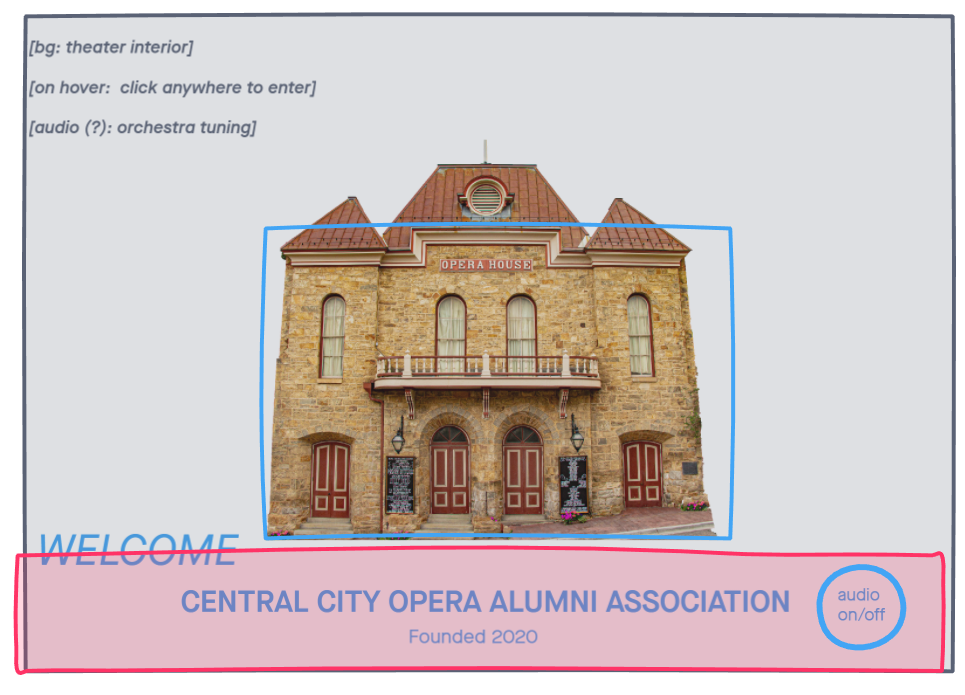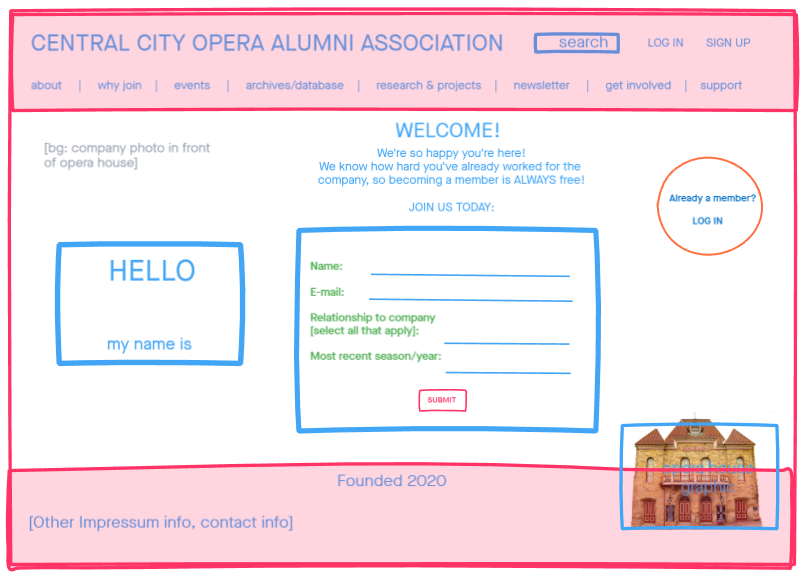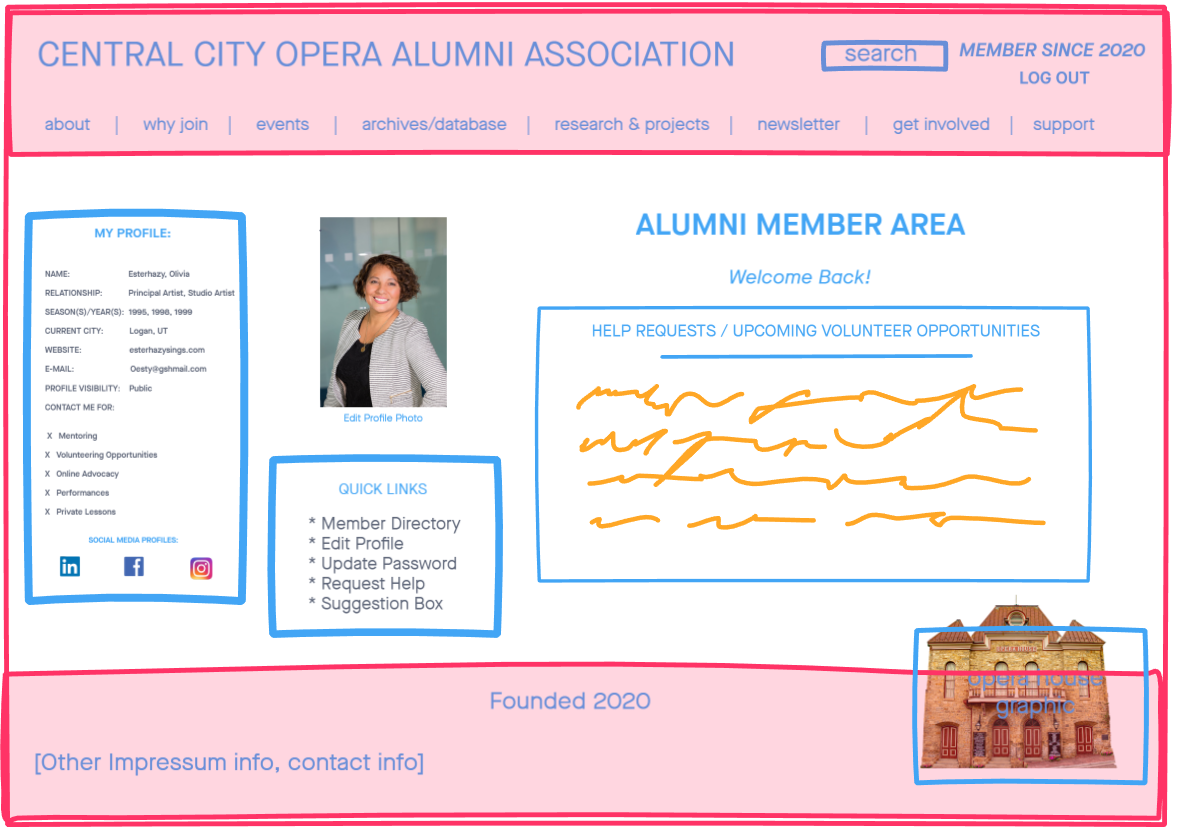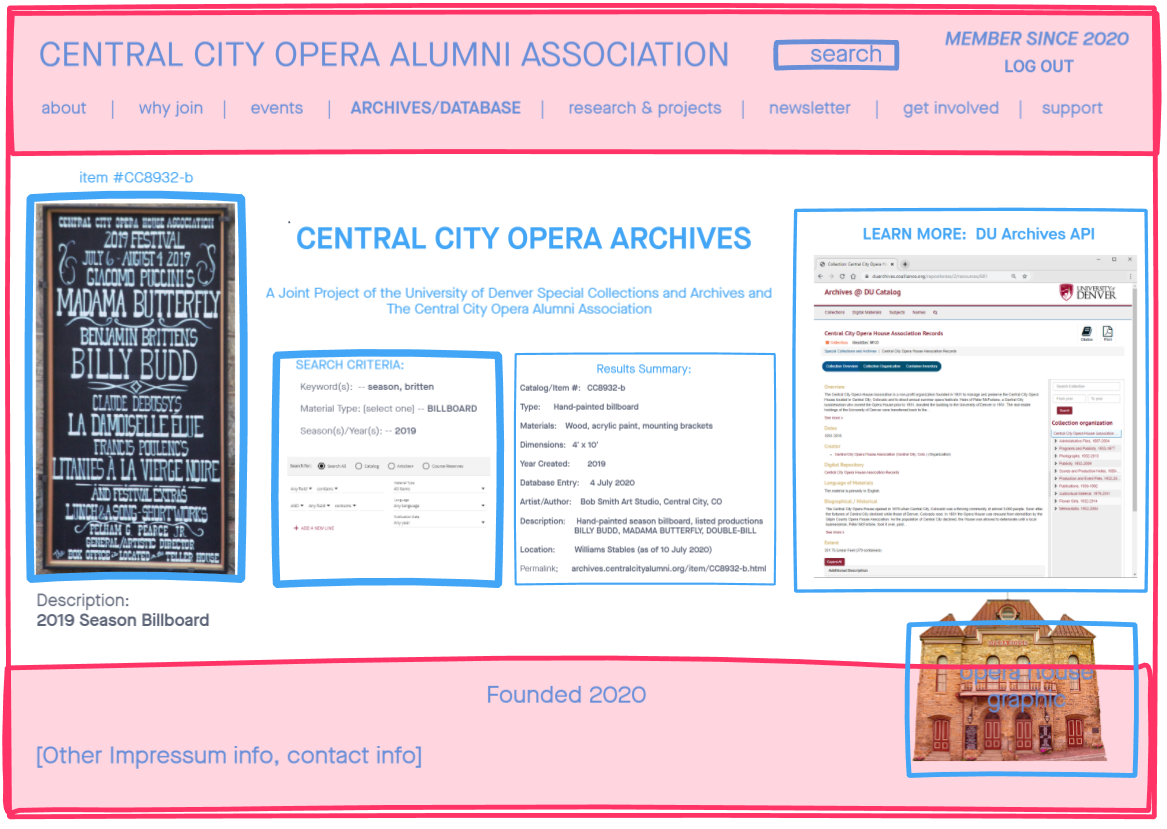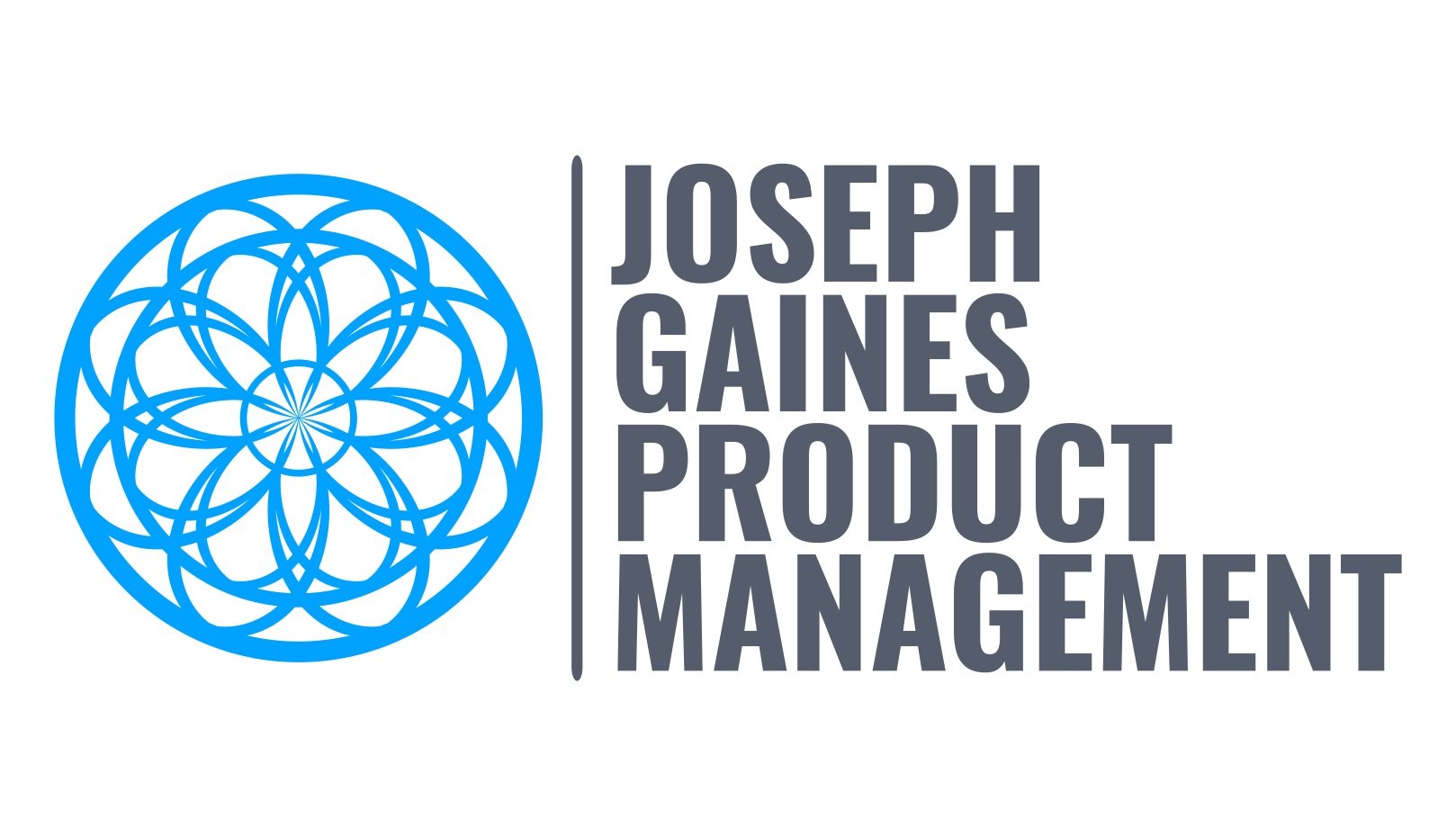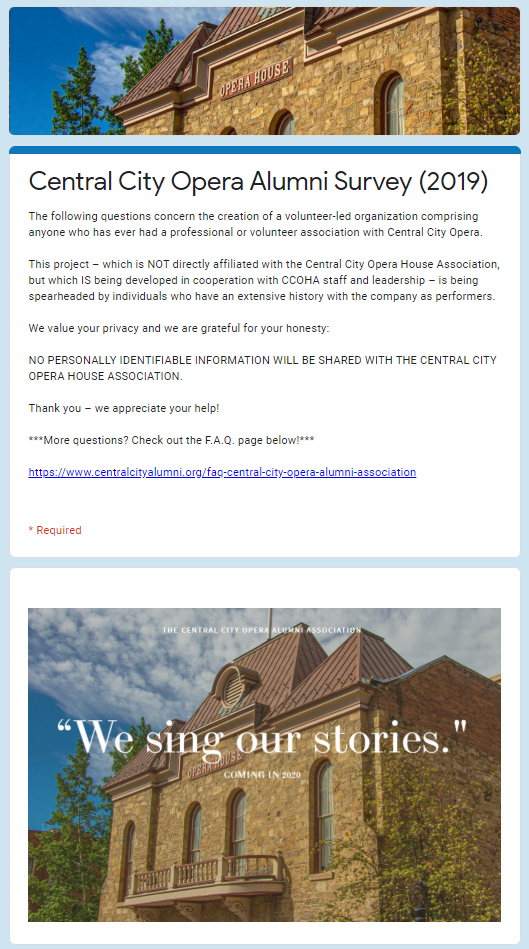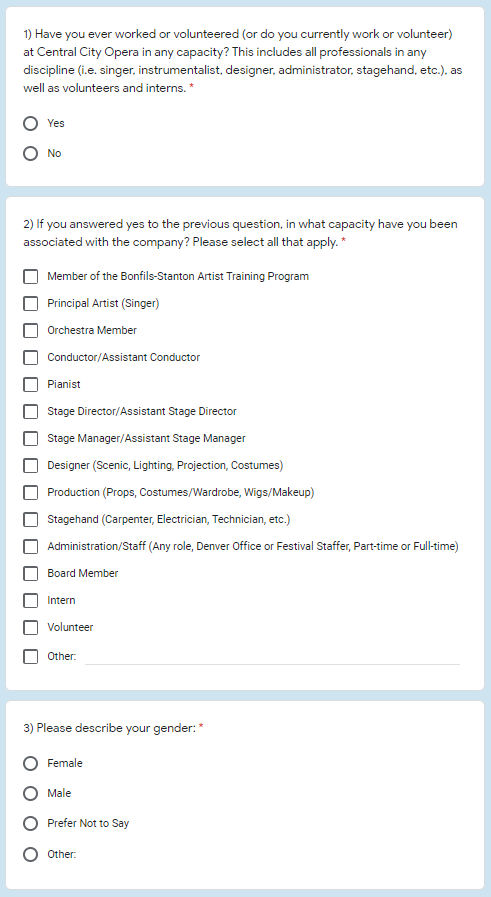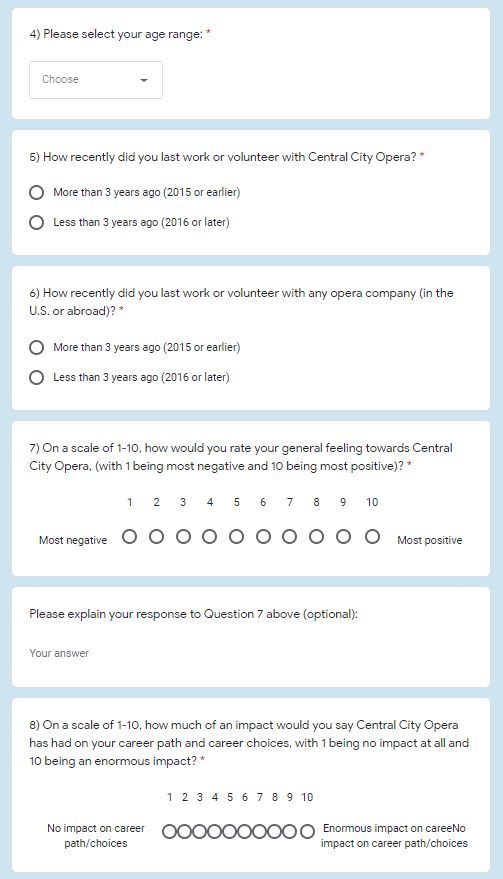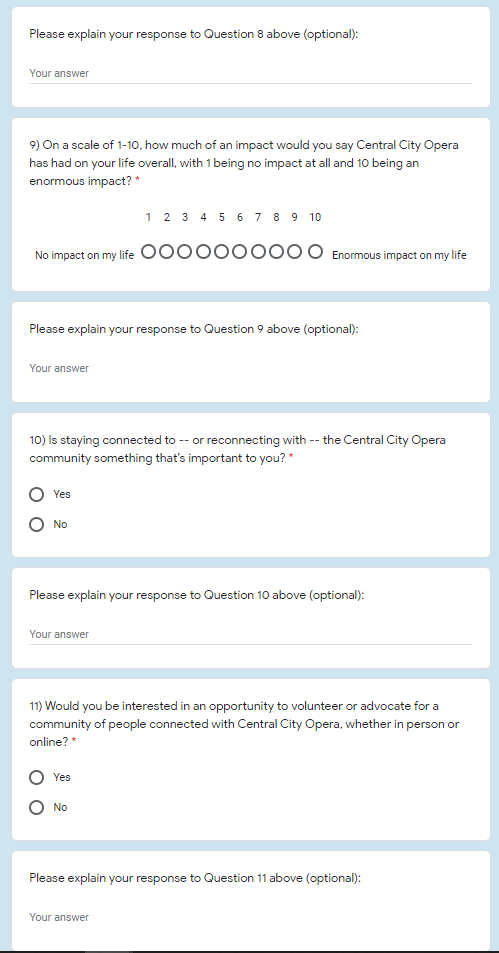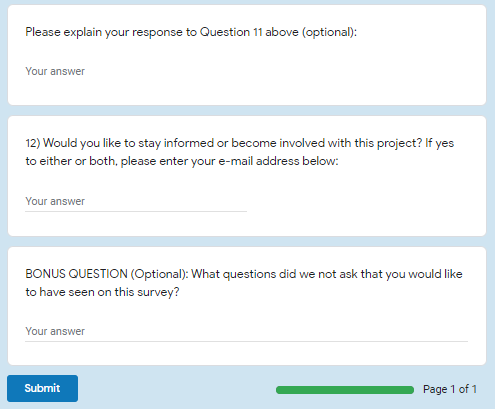THE ALUMNI PROJECT —
A CASE STUDY
Institutional Memory, Digital Archiving, and Building an Alumni Association from Scratch
PROJECT OVERVIEW
Sector : Nonprofit, Arts, Community Organizing
Challenge(s): Multi-faceted: the subject organization, Central City Opera, has a wealth of passionate supporters by way of former employees, contractors, and volunteers; these cohorts usually cease to have any direct connection to the company after the end of a given performance season or contract, which represents multiple missed opportunities. They also represent multiple generations of living institutional memory going back several decades which remain largely untapped and unrecorded in a concentrated and readily available manner. And while a local university has begun a major archival project of their own, there are still entire classes of physical objects and properties of which there is little to no digital or photographic documentation, making them vulnerable to destruction and permanent loss.
There’s also no current industry standard way of appropriately/meaningfully reconnecting these potential advocates with the company — which means we had to build a new one entirely from scratch.Solution : A web-based, first-of-its-kind alumni association for one of the oldest opera companies in America, with UX Design, Arts Leadership, Product AND Project Management, all rolled into one ambitious endeavor.
My Roles: Ideation, Project Management, Product Management, UX Research, UX Design, Branding
Collaborators:
- Emily Pulley: Operatic Soprano, Stage Director, Educator, and Central City Opera Alumni Association Co-Founder & New York Director.
- Kate Dignan: UX Design Colleague & Front End Developer who has provided invaluable advice and encouragement along the way.
Project Time: 9-12 months from ideation to deployment of MVP
Status: Ongoing
contents
BACKGROUND
The historic Opera House in Central City, Colorado. Photo: Supernal Geography
Subject: Central City Opera, an 87-year-old opera company, the fifth-oldest in the United States.
How I Got Involved: A professional opera singer for about 15 years myself, I’m a former apprentice trainee as well as guest artist over multiple seasons at this opera company. I have a relationship with Central City Opera stretching back over a decade; they were one of the first professional companies to really believe in me as an artist, and their impact on my life and career cannot be overstated. More recently, over the course of about a year, conversations with my colleague Emily Pulley (who has an even longer history there than I) led us to believe there were major opportunities for support, preservation, and growth which were being missed. During the 2019 summer season, Pulley and I proposed a solution to the company, and were given the green light to proceed.
What it Means to The Company: Suddenly finding yourself with a network of enthusiastic supporters, each with their own, preexisting relationship and history to the company, and primed to lead in or contribute to advocacy or preservation efforts — and all at virtually no cost to the company? What’s not to like?
What it Means to Me: Creating a volunteer leadership role both to support the company a unique and powerful way, as well as to help educate myself further on UX practices as I move into the field. The top two pieces of advice I’ve been given by both senior UXers and Product Managers in the first 18 months since I began this journey into UX & PM have been:
1) build something
2) seek problems (and solutions) for which you can offer unique domain expertise.
If the Alumni Project wouldn’t have checked both of those boxes for me, I have no idea what else would.
Related/Read More:
UNDERSTANDING THE PROBLEM(S)
What needs to be solved?
The problem is two-fold: there are both missed opportunities, as well as no current paradigm to address said missed opportunities.
Problem #1: Former artists, staffers, interns, and volunteers often leave Central City Opera with strongly positive feelings about the company, its mission, and their time there. They may represent a huge, untapped well of potential support for the company in the form of passion, nostalgia, and affection.
Problem #2: However, there’s currently no meaningful way for them to reconnect with the company or its community after their contracts/seasons end. The nonprofit arts business model in the U.S. neither provides a solution nor incentivizes the company to find one.
Why does this matter? All opera companies in the United States are nonprofits. Their fundraising staff (i.e. their Development departments) are tasked with raising money — in fact, box office revenue typically makes up less than 40% of annual revenue in any given year; the rest is contributed or the proceeds from (not always, but often quite limited) investments.
However, working artists and artisans in the opera industry are overwhelming self-employed and often make so little as to qualify as the working poor, and often are operating with a scarcity mindset, meaning that — no matter how much they might represent an untapped wealth of enthusiasm and energy for opera companies — they are hardly the target demographic for regular fundraising.
The Bottom Line — Means and Incentive:
No matter how positively “alumni” (in the broadest sense) of any opera company may feel about said company, there’s currently no means for these alumni to connect/reconnect with the company, and there’s usually no real incentive for the company to reach out to these “alumni” for support, either.
Related/Read More:
MARKET? USERBASE? "ALUMNI"?
How does an opera company have “Alumni”?!
For our purposes, “Alumni” describes anyone and everyone who has ever had a professional or volunteer relationship with the company.
We tried without success to brainstorm other words, but “alumni” kept rising to the top of the list, every single time.
Most relationships with this summer-presenting performing arts organization are strictly time-delimited and related directly to a season year (i.e. regardless of whether you sing or build sets or work as a stage manager, you are typically hired per annual summer season; i.e. one would say, “I was last there in the 2015 season…”).
Therefore, describing the majority of contractors for whom that is true — and then, for simplicity’s sake, including the minority for whom it isn’t true, like full-time/year-round employees — is how we arrive at the descriptor of our proposed solution to the aforementioned problems, the creation of The Central City Opera Alumni Association, which marks both a first for the company, as well as the first organization of its kind for the entire U.S. opera industry.
Once we got the etymology nailed down, we then had to figure out who exactly these “alumni” might be — and whether they even wanted us to pursue an “Alumni Association” at all.
“When in doubt, map it out…”
One of the simplest (and best) tools available to kick off the user research process is the affinity map (a.k.a. affinity diagram.) Put simply, it’s a way to cluster ideas in a visual way — one which informs how you think about what you should do next.
In the affinity map above, I wanted to more simply and visually see the small universe of characteristics describing those who will a) answer the survey(s) I publish and/or b) eventually constitute my userbase/market. Given that we’re employing the term “alumni” in a somewhat unusual (though still fairly intuitive) way. I decided three major gravity wells of information I wanted to map out/populate included
1) Identities/Roles/Company Relationships: What did they actually do with/for the company?
2) Dimensions/Characteristics (i.e. Demographics): What are some of their key qualities?
3) Sentiments: How do they generally feel about things relative to the opera company?
General thought process:
I used a bit of color coding: for the “Sentiments,” green=good/positive, red=neutral or bad/negative; otherwise gold for demographics, and green under identities, as well.
For “Sentiments,” I was concerned primary with four areas of positive/neutral/negative inclinations:
a) their time at the company, b) what they thought of the work in particular, c) what they think about the future prospects of the company, and d) what they think about the future prospects of the opera industry overall.
Roles are grouped roughly by department or by most frequent interaction (singers, conductors, pianists, music staff, young artist instructors); (backstage production staff); (directors/designers/stage management); (administration/employees); (volunteers/volunteer leadership like the board, the guild)
For the demographics/dimensions/characteristics, the following were important to me, broadly speaking: age, where people are based, whether they’re on the YAP (young artist program/apprentice training) circuit, whether they’re still active in the industry, the degree to which they’re still involved in academia as students or teachers, whether they’re union (as unions are hugely important to many American opera houses, including this one.)
Related/Read More:
THE UX RESEARCH PROCESS, PART I:
ASKING QUESTIONS
The next tool in our research toolkit is a survey. Got questions? Write ‘em out, think ‘em through, prioritize them — then pose them in the form of a survey.
Even though the survey ended up with 12ish questions, all of them (the entire survey) were really only designed to answer just one question in particular: did other people think this whole endeavor would be worthwhile? Yes or no. In other words, was there actually a problem to be solved?
Given that software development generally is littered with decades’ worth of elaborate solutions in search of nonexistent problems, for our purposes, it’s by far the first and most important question of all.
After consulting with a couple of very generous colleagues from both opera and tech, I settled on the following questions. I also followed up many quantitative questions (i.e. multi-choice, drop-down menus, sliders, etc) with an opportunity for respondents to answer qualitatively, as well (i.e. “Why did you answer that way?” followed by an empty text box).
For simplicity’s sake (and cost), I opted to use Google Forms to build the survey:
FALL 2019 ALUMNI SURVEY QUESTIONS:
“1) Have you ever worked or volunteered (or do you currently work or volunteer) at Central City Opera in any capacity? This includes all professionals in any discipline (i.e. singer, instrumentalist, designer, administrator, stagehand, etc.), as well as volunteers and interns.
2) If you answered yes to the previous question, in what capacity have you been associated with the company? Please select all that apply.
3) Please describe your gender:
4) Please select your age range:
5) How recently did you last work or volunteer with Central City Opera?
6) How recently did you last work or volunteer with any opera company (in the U.S. or abroad)?
7) On a scale of 1-10, how would you rate your general feeling towards Central City Opera, (with 1 being most negative and 10 being most positive)?
8) On a scale of 1-10, how much of an impact would you say Central City Opera has had on your career path and career choices, with 1 being no impact at all and 10 being an enormous impact?
9) On a scale of 1-10, how much of an impact would you say Central City Opera has had on your life overall, with 1 being no impact at all and 10 being an enormous impact?
10) Is staying connected to -- or reconnecting with -- the Central City Opera community something that’s important to you?
11) Would you be interested in an opportunity to volunteer or advocate for a community of people connected with Central City Opera, whether in person or online?
12) Would you like to stay informed or become involved with this project? If yes to either or both, please enter your e-mail address below:
BONUS QUESTION (Optional): What questions did we not ask that you would like to have seen on this survey?”
Going forward, we’re planning a second survey in late Winter/early Spring 2020 to really drill down into the data we have now as well as to help prioritize features for the MVP. If the first survey was essentially one giant YES/NO question, the second will address more of the HOW/WHAT.
“You are here — and now you can go there:” Building Userflows
To help orient people arriving at centralcityalumni.org to either take the survey (or learn more about it), I needed to map out some user flows. In the super-duper simple, starter website, there were basically only three components:
1) The Fall 2019 Alumni Survey
2) An e-mail capture form (in case people who took the survey missed or skipped the e-mail capture field built into the answers). It generated some duplicate entries, but also snagged a few extra, as well.
3) An F.A.Q. — added later, though it was always an intended feature.
Then it was important to map out how the above three components related to one another. Below, check out both my low-tech (pen & paper!) & high-tech (a Miro board!) versions of a User Flow diagram for the survey & its overall website:
Answering those Frequently Asked Questions
As a number responses to the survey continued to roll in, in became clear that we hadn’t yet done a good enough job explaining what we were about in both the survey and our ideas for the Association. Most people had read the initial disclaimers and explanations and most were able to understand what we were doing from the context of the survey questions themselves — most, but not all.
So, we moved it up the priority list and added about halfway through the six-week survey period. After the survey closed, I tweaked the F.A.Q. a bit to reflect both that the survey was now in the past, as well as to answer questions about The Alumni Project more generally.
THE UX RESEARCH PROCESS, PART II:
GETTING ANSWERS
What Did We Learn from the Survey? Building Personas & Making Sense of it All
After approximately six weeks online in the Fall of 2019, we decided to close the survey having received a total of 82 responses.
What worked?
Google Forms was indeed a simple, free, and utterly reliable. The survey was super easy both to build and to publish, and the instant gratification of seeing so many responses begin to pour in within minutes of publishing to social media was great!
What were the challenges?
Honestly, it went more or less as we hoped, and 82 is a goodly number of responses.
That said, it was not nearly as many as I had perhaps dreamed, just knowing how many “alumni” were out there. There are at a bare minimum many hundreds, if not several thousand people, who could have completed this survey. Hundreds! Thousands! Surely these throngs of enlightened, lovely, generous potential users would simply flock to us! Huzzah!
But actually finding them — at least beyond the initial push in our own (admittedly large) social media circles — was harder than I thought.
“You’re doing, uh, what now…?”
While it was generally easy to get communication leaders of various groups of “alumni” interested in our project — including key local and national union reps who had expressed interest, and who held e-mail distribution lists with dozens, if not hundreds, of my very target recipients — it was hard to convince them to make it a priority. Ultimately, the 82 we received probably represent only those we reached via Facebook. I began some good conversations this time around, though, and I hope to be able to capitalize on them for future efforts (like the next survey, which we hope to launch in spring 2020 to dig deeper into the responses we received.
“Target users who like the Opera Browser and work in Center City Philadelphia? Right, we’ll get right on that…”
Also, I had used Facebook’s ad platform before (when trying to reach audiences to spread my “brand” as a singer, boosting posts from my FB fan page and the like). In my recollection, you could get suuuper, intensely detailed in terms of targeting users — including people who listed many individual opera companies as their employer. But perhaps in light of Facebook’s recent ethical troubles regarding targeted advertising, this feature had been sharply curtailed.
Without the ability to get super specific in terms of our audience (e.g. people who “liked” Central City Opera’s own FB page, or those who listed the company as a past employer), we risked diffusing the message and advertising our project in such a way that would have made us appear clumsy and club-footed. So, after banging my head against various proverbial desks and walls over several days with both Facebook and Google AdWords, I decided to set aside that tactic.
WHO ANSWERED THE SURVEY?
Take a look! I haven’t included responses to all questions, but here are some key ones that gave us great insights:
Question 2: The overwhelming number of survey respondents (approx. 80%) were singers (not surprising, given that most responses came via my own and Emily’s social networks — and most of the people in operaland we know are singers. This represented a personal frustration of mine — it takes WAY more humans to make an opera than just singers like yours truly — but as I mentioned above, there were simply limits to what I could get done this time around in terms of getting the survey in front of more apropos eyeballs.
(The text on the graph generated by Google Forms isn’t super well laid out there, but essentially 52 respondents were former members of the Bonfils-Stanton Artist Training Program (i.e. apprentices/studio artist trainees) and 13 were principal artists (the leads and main supporting roles), which is from where I derived the 80% singer-respondents figure.)
HOW ENGAGED ARE THEY?
Questions 5 and 6: While we are trying to gather any and all who’ve either worked or volunteered at Central City Opera, without wanting to get too far into the demographic weeds for this first survey, we wanted to at least get a sense not only of how many had a relatively recent affiliation with the company, but also how many were effectively still “in” the business in one way or another.
Rather than asking that last bit outright — which anyway is rather subjective in a field dominated by self-employed contractors forever stringing together an income from multiple 1099 contracts per year — we asked a substitute question indicating whether someone was last active in the field within the last 3 years or no. Totally anecdotally, I can vouch for having met vanishingly few people who hadn’t done anything with an opera company in the last 3 years who would identify themselves as still active in the biz. There are of course exceptions, but it felt like the most useful proxy for obtaining that particular data point.
Just under half were involved with the company within the last 3 years; 90% were active with at least some opera company somewhere in the world at some point within the last 3 years, which tells me that the remaining 10% would likely self-identify as no longer being active in “the biz.”
It’s an ancillary metric, but one that’s important: overall engagement with the industry as a whole and with this company in particular.
HOW DO THEY FEEL?
Questions 7, 8, and 9: Now, while I’m reasonably good with numbers, I’m not a data scientist. That said, I fall more in the camp that is generally skeptical of the Net Promoter Score (NPS), which essentially asks you to take the “On a scale of 1-10” responses you’d get from a survey like this and divvy everyone up into three groups: 1) detractors (0-6), passives (7-8), or promoters (9-10).
(And yes I realize typically NPS is based on a scale of 0-10 and I used a scale of 1-10 — but I digress…)
Call me biased in favor of the company being perceived most positively (entirely possible, given my background), but based on my own experience and that of working with artists and other arts-minded professionals that there are often “more things in Heaven and Earth than are dreamt of in your philosophy.” That is to say, nuance matters deeply to myself and my colleagues, and at least on a gut level, I have a very hard time applying either the NPS or the eNPS (“employee Net Promoter Score” — which has its own basket of problems and critics) and its fixed set of categories. So, I’m not gonna.
So observe that, while there are some for whom the company is either meaningful or represented a negative experience, by a large margin the majority of responses trend to the positive:
WHAT DO THEY WANT?
Questions 10 and 11: And now we come to the two questions for me form the heart of the survey as a whole, and upon which we essentially hang our decision to pivot or persevere with this whole endeavor.
Question 10 asked whether connecting or reconnecting with the Central City Opera community is important to the respondents: 78% said yes.
Question 11 asked whether they’d be willing to volunteer or advocate for the company, whether in person or online: 62% said yes.
CONCLUSION
So what is our takeaway?
Based on these numbers, we believe our initial hypothesis has been validated.
There is indeed an unmet need for connection among most of those we call Central City Opera “Alumni,” a majority of them want to help if they can — and we may have just the solution, already in the works.
THE UX RESEARCH PROCESS, PART III: BUILDING PERSONAS
So you built and published a survey. You got some great data. What happens now?
We know that at least 82 people were interested enough in our project that they took the time to complete our survey — often in depth. Not only did we get some great quantitative data in the form of demographics (age range, gender, their relationship(s) to the company, etc), but we also got great qualitative data by way of what people wrote in the “Please explain your answer above” boxes. That, frankly, is where we were really able to dig down into people’s motivations, their likes and dislikes. It’s what makes the notion of NPS largely useless for our purposes, since the relationship of any former employee, contractor, intern, or volunteer to Central City Opera is a very complex one, indeed.
The problem is that we anticipate the Central City Opera Alumni Association ultimately having several hundred (if not a few thousand) active users, and trying to build a single product which completely satisfies such a dizzying array of motivations, likes/dislikes, needs, and wants is completely impossible. We need trends, we need big pictures — we need personas.
What are personas and how can we use them?
Below you’ll find biographies for four different people. They’re lovely humans (you’d like them a lot), and each has a unique relationship to Central City Opera: one is a younger singer and recent graduate of the Bonfils-Stanton Foundation Artist Training Program; another is a former intern-turned-marketer; we also have a professional costume designer based in New York who spent some time working in the company’s Costume Shop back in the day; and finally an older, well-established singer who is now on faculty in a prestigious university voice department.
They also have something else in common: they’re all completely fictional. None of them are real people. Not a single one. Their images were sourced from royalty-free stock photography sites online; their names, ages, and purported relationships to the company are all completely fabricated.
As Nick Babich of The Adobe Blog writes, “Personas are archetypical users whose goals and characteristics represent the needs of a larger group of users.”
And Wikipedia describes a persona as “a fictional character created to represent a user type that might use a site, brand, or product in a similar way.”
However, the quotes you see under “General Feedback” are completely real — they are taken directly from the qualitative feedback we got on the survey, lightly edited (for both clarity and for the anonymity we promised our survey respondents), and aggregated in a way that might help us make sense of our potential users/members/alumni going forward.
So — please meet our new friends: Valerie, John, Olivia, and Eric:
Related/Read More:
PRODUCT VISIONS & SOLUTIONS
What might we build — and when?
The possibilities are endless!! But let’s sketch out a few…
MOCKUPS — centralcityopera.org
Made with Figma.


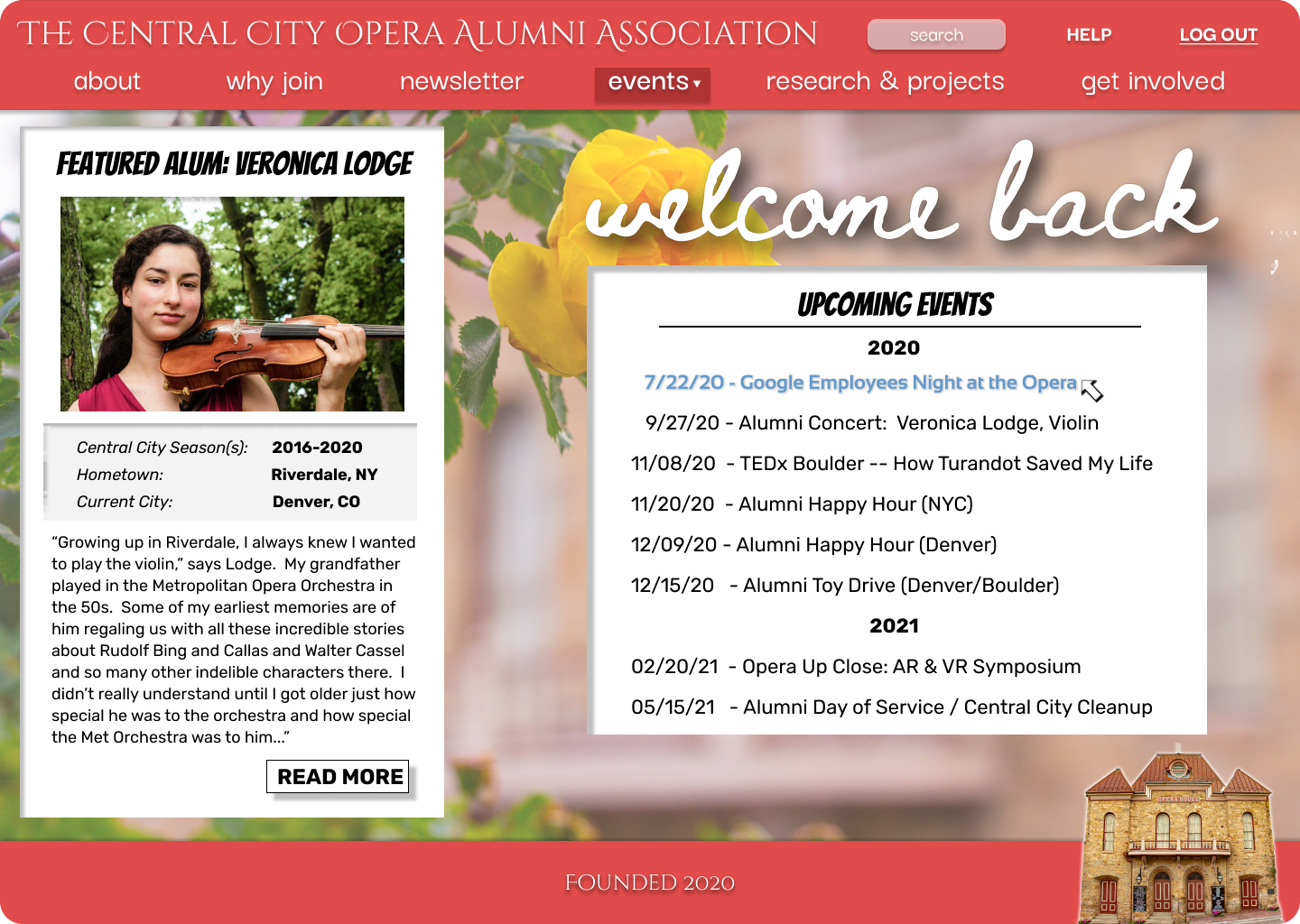

WIREFRAMES — centralcityopera.org
Made with Invision.
